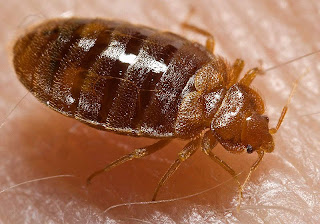Bed Bugs and Bat Bugs
Bed Bugs and Bat Bugs
Bed bugs (Cimex lectularius) and Bat bugs (Cimex adjunctus and C. pilosellus)Cimidoidea
Bed bugs are parasites that feed on humans.
Occasionally “bed bug” problems are actually caused by bat or bird bugs that can be found in buildings that have bats or birds living in the structure.
Public health significance:
Although both bed bugs and bat or bird bugs will bite people,only bed bugs feed on human blood.Bed and bat or bird bugs have not been found to transmit any diseases to humans. However,secondary infections resulting from scratching the bites can occur and should be cleaned and treated accordingly.Repeated exposure to bed bug bites may cause some people to become sensitized to the saliva and result in mild to intense allergic reactions.
Sources of infestation:
Bed bugs are bought into home on infested furniture or in luggage and personal belongings after staying in infested lodgings.In apartment buildings,townhouses,hotels and other connected dwellings bed bugs can migrate from one infested unit into other via electrical wiring, plumbing and adjoining walls.Socio-economic considerations:Bed bugs and bat bugs can and will infest the humblest of homes and the most extravagant hotel or mansion if given the chance.
Eggs are white in color and approx 1 mm in length and glued to the surface they are laid on.Eggs are laid in the crevices and surfaces where the adult bed bug hides during non-feeding periods and hatch in 6 to 10 days depending on temperature.
The newly hatched nymph (approx. 1.5 mm) is white to pale yellow until their first blood meal after which they become reddish-brown in color.
Development time from first nymph stage to sexually mature adult is 35 to 48 days under favorable environmental conditions.The bed bug requires a blood meal for each of the five nymphal stages, as well as a blood meal by the adult female before she can lay eggs.
Female bed bugs lay 1 to 5 eggs after each blood meal and can lay a total of 200 eggs during its lifetime of approximately 9 to 18 months.
Bed bugs can survive over 6 months between blood meals if a host is not available.
Adult bed bugs are reddish brown in color,approximately 7 mm long,egg-shaped with a segmented abdomen, and are flat top to bottom.
Generally,bed bugs are nocturnal,feeding when their host is asleep but will adjust their feeding habits to match the sleeping habits of the host.For example,if the host begins working at night and sleeps during the daytime hours, bed bugs will become day feeders.If the host begins sleeping in another room, bed bugs will follow to the new location.
During non-feeding periods,bed bugs will hide in cracks and crevices in close proximity to the host (e.g., mattress seams,bed frame,headboard,box spring,behind wall hangings or baseboards,torn wall paper, bedroom furniture, etc.).
It takes a bed bug about 5 to 10 minutes to finish a blood meal.The bites are painless, so the host is unaware they are being bitten.
An integrated program of inspection, chemical and non-chemical measures followed by monitoring is required for control of bed bugs.
Housekeeping:
Transporting bed linen,blankets,etc in a plastic trash bag to be laundered in hot water.Items that cannot be laundered in hot water can be placed in a dryer at high heat for 30-40 minutes.
Inspection of places where bed bugs hide (e.g.,bed frame,headboard,box spring,mattress,behind wall hangings,in bedroom furniture,edge of carpeting etc.) and vacuuming them up(and disposing of the vacuum bag) when they are found.
Minimize floor clutter (e.g.,boxes,books,clothing,etc.) to reduce the number of bed bug hiding places.
On hot,sunny days,place infested mattress,bed frame,headboard,etc outdoors in the direct sun,turning them periodically to drive bed bugs out of infested furniture.
Apply diatomaceous earth (broken up shells of tiny critters) powder to cracks and crevices behind baseboard coving and in floor cracks,and other hiding areas that are out of sight. Diatomaceous earth works by slicing open the exoskeleton (outer, hard covering) of insects, causing them to dehydrate and die.
Seal cracks and crevices along base board coving and floors with caulking.
Chemical control:
The homeowner can do this by applying an insecticide into all the cracks and crevices in the infested room.Following label instructions, apply over-the-counter insecticides that are registered for bed bugs to infested box springs,mattress,bed frame,furniture,crack and crevices,etc.
It is usually recommended that a professional,commercial pesticide applicator be hired to apply the chemical pesticides.They have the experience and knowledge in bed bug control strategies along with the having the proper equipment to apply pesticides into cracks and crevices. In addition,professional applicators can use more effective pesticides with residual properties that continue to kill bed bugs after they’ve been applied.
Monitoring:
Following control procedures,monitoring of further bed bug activity is necessary to ensure that control was successful.If evidence of live bed bug activity is found,additional control measures are needed until no activity is observed.
Inspection of mattress, headboard, bed frame,etc. where previous bed bug activity was noted.
Continued blood spotting of sheets.
Fresh bites.
Adhesive traps that collect insect pests as they cross over its sticky surface.


Comments
Post a Comment